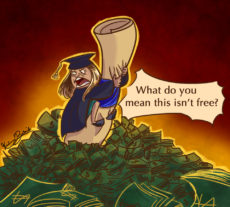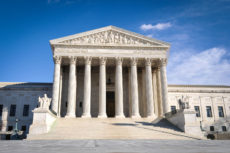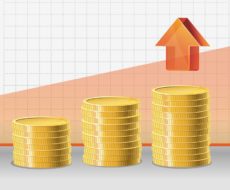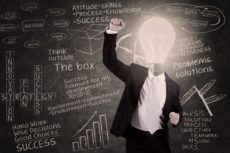Abigail R. Hall • Thursday, May 19, 2016 •
 When I graduated from college, reality hit. I was now considered a “real adult.” In a matter of months I’d be moving out of my parents’ basement and some 700 miles away to start graduate school.
When I graduated from college, reality hit. I was now considered a “real adult.” In a matter of months I’d be moving out of my parents’ basement and some 700 miles away to start graduate school.
I was also struck by something I knew was coming, but hadn’t quite appreciated.
That “something” was my student loans.
There they were in black and white, those things I’d been taking out for some 48 months to pay for a Bachelor’s degree from a small liberal arts university. I owed tens of thousands of dollars and the bill was coming due. (For the record, I could have deferred payment as I was going to graduate school, but chose not to in order to avoid paying more interest.) I remember feeling overwhelmed. I’d never owed that much money in my life!
Certainly, I am not the only one who has faced student loans. It’s estimated that my follow graduates and I owe more than $1 trillion for their educational expenses. About 70 percent of graduates in 2014 had student debt averaging about $33,000.
Abigail R. Hall • Thursday, May 19, 2016 •
 Late last year Turing Pharmaceuticals provoked a serious backlash after hiking the price of the pill Daraprim from $13.50 to $750 per pill. The head of the company defended his firm against the criticism, but many found his arguments lacking.
Late last year Turing Pharmaceuticals provoked a serious backlash after hiking the price of the pill Daraprim from $13.50 to $750 per pill. The head of the company defended his firm against the criticism, but many found his arguments lacking.
While we may question the overnight price jump of more than 5,400 percent, economics tells us why many drugs are so expensive.
The first reason is the cost of development. The Tufts Center for the Study of Drug Development estimates that the average cost of developing a new drug is around $2.6 billion. On average, only three in every 10 drugs will make it to market and be profitable. In this light, it is obvious why pharmaceutical companies may charge higher prices. To stay in business the companies must charge enough for their few profitable drugs to recover the costs of developing those drugs plus the others that fail.
Some argue that drug companies particularly exploit individuals suffering from rare conditions. Forbes found nine drugs that cost each patient more than $200,000 annually. While this may sound outrageous, consider that these medicines treat diseases affecting fewer than 10,000 people, a small market for a drug company. Higher prices and greater profit opportunities give pharmaceutical companies stronger incentives to develop these drugs. Without such incentives, the drugs likely wouldn’t be created at all.
John R. Graham • Thursday, May 19, 2016 •
 Obamacare’s opponents are cheering the Little Sisters of the Poor’s apparent Supreme Court victory over Obamacare’s mandate to cover artificial contraception, about which I wrote when the controversy first erupted.
Obamacare’s opponents are cheering the Little Sisters of the Poor’s apparent Supreme Court victory over Obamacare’s mandate to cover artificial contraception, about which I wrote when the controversy first erupted.
The Little Sisters defied the mandate, which is contrary to their Catholic faith. The mandate is relevant not to the nuns’ themselves (obviously), but to their lay employees who work in the Little Sisters’ nursing home and are covered by their plan.
The Supreme Court decision is not complete victory: SCOTUS vacated judgments and fines approved by lower courts and sent the case back to lower courts to give the Obama administration time to find another way to get contraceptive coverage to the Little Sisters’ lay employees.
Bravo to the nuns for standing up to Uncle Sam. However, I am growing increasingly concerned that advocates of small government have surrendered a lot of ground in the fight for individual liberty. Unless a person or persons have a sincerely held religious objection to a federal mandate, it is widely accepted that they must obey. There are a lot of problems with this principle.
Mary L. G. Theroux • Thursday, May 19, 2016 •
The authors of the new Independent Institute book, Nature Unbound, assert that “human beings are an integral part of the natural order and merit no less consideration than Earth’s other treasures.”
To those who do not realize what a radical notion this is in today’s mainstream environmentalism—which views human beings as wholly foreign to “nature”—I offer Exhibit A: a recent article in the San Francisco Chronicle headlined, “Early Life of Harmony: 1st Indian Inhabitants Lived in Harmony by the Bay.”
Reading the story, one wonders at the author’s definition of “harmony.”
Robert Higgs • Wednesday, May 18, 2016 •
 For as long as economic growth has been a noticeable phenomenon—at least since Adam Smith’s day—economists, historians, and others have advanced theories to explain its occurrence. Many of these theories have identified a single factor that is regarded as “the answer” to the question at issue. Thus, the exploitation of wage labor, the enslavement and exploitation of African slaves, the presence of certain raw materials, the presence of a certain religion, and many other factors, one by one, have occupied center stage in these portrayals. Because all such theories have fairly obvious shortcomings, analysts have spent much time refuting one another’s pet hypotheses. Since World War II, the economics profession has even created a new subfield called development economics to deal with these disputes, often by the formulation of novel mathematical models or the econometric testing of various hypotheses. Notwithstanding all of these efforts, debates about the one or the main factor behind the process of modern economic growth have scarcely been settled, even among well-informed professionals.
For as long as economic growth has been a noticeable phenomenon—at least since Adam Smith’s day—economists, historians, and others have advanced theories to explain its occurrence. Many of these theories have identified a single factor that is regarded as “the answer” to the question at issue. Thus, the exploitation of wage labor, the enslavement and exploitation of African slaves, the presence of certain raw materials, the presence of a certain religion, and many other factors, one by one, have occupied center stage in these portrayals. Because all such theories have fairly obvious shortcomings, analysts have spent much time refuting one another’s pet hypotheses. Since World War II, the economics profession has even created a new subfield called development economics to deal with these disputes, often by the formulation of novel mathematical models or the econometric testing of various hypotheses. Notwithstanding all of these efforts, debates about the one or the main factor behind the process of modern economic growth have scarcely been settled, even among well-informed professionals.
Recently my old and greatly esteemed friend Deirdre McCloskey has attracted much attention to her trilogy The Bourgeois Era, in which she advances (again) the notion that the process of modern economic growth—as she calls it, the Great Enrichment—has sprung mainly and fundamentally from a change in reigning ideas, in particular, from cultural changes that began in Holland and Great Britain in the seventeenth and eighteen centuries and accorded for the first time great respect to innovators and capitalists who carried out the technological and economic changes whereby the rate of overall economic productivity growth was raised to a much higher level and average incomes increased eventually by a factor of 30-100. McCloskey, with tremendous erudition, argues against all the previously advanced theories—material capital accumulation, human capital accumulation, slavery, improved institutions (in particular, better-established private property rights), the presence of certain raw materials such as iron or coal, and all the others—and offers instead her own explanation rooted in the cultural and ideological changes that have often been lumped under the rubric of “liberalization” in the old, classical liberal sense of this term.
Vicki E. Murray-Alger • Wednesday, May 18, 2016 •
 This month marks the 62nd anniversary of the landmark Supreme Court case, Oliver Brown et al. v. Board of Education of Topeka, Kansas, which struck down the notion of “separate but equal” public schooling for black students. In spite of the civil rights advances we’ve realized over the past several decades, equal educational opportunities remain out of reach for far too many American school children.
This month marks the 62nd anniversary of the landmark Supreme Court case, Oliver Brown et al. v. Board of Education of Topeka, Kansas, which struck down the notion of “separate but equal” public schooling for black students. In spite of the civil rights advances we’ve realized over the past several decades, equal educational opportunities remain out of reach for far too many American school children.
According to former US Secretary of Education Arne Duncan, in 1980 “the U.S. Department of Education opened with a mission to ensure equal educational opportunities for all students.” How? By spending more…lots more.
Back in 1980, the department spent nearly $7 billion, roughly $20 billion in current dollars, on elementary and secondary education, directing about half of that to Title I schools enrolling high proportions of low-income students. Today, that budget has more than doubled to almost $43 billion.
Yet over the same period elementary and secondary student enrollment grew less than 25 percent, from 41 million students to 50 million students. This means U.S. Department of Education spending has outpaced student enrollment by more than four to one.
John R. Graham • Tuesday, May 17, 2016 •
 The Employee Benefits Research Institute (EBRI), a research organization with a mission “to contribute to, to encourage, and to enhance the development of sound employee benefit programs and sound public policy through objective research and education,” includes members as diverse as AARP, Aetna, Boeing, Charles Schwab, and Wal-Mart. In the benefits world, it sits firmly inside the establishment.
The Employee Benefits Research Institute (EBRI), a research organization with a mission “to contribute to, to encourage, and to enhance the development of sound employee benefit programs and sound public policy through objective research and education,” includes members as diverse as AARP, Aetna, Boeing, Charles Schwab, and Wal-Mart. In the benefits world, it sits firmly inside the establishment.
That is why EBRI’s latest research on how employees view their benefits should give some encouragement to reformers who want to change the tax treatment of health insurance, and weaken the iron triangle of big business, big labor, and big government that enforces the discrimination against individually owned insurance. From EBRI’s latest Note:
- There appears to be the start of a trend away from being satisfied with the current mix of benefits and wages, toward more preference for fewer health benefits and higher wages. Between 2012 and 2015, the percentage of workers reporting that they are satisfied with the health benefits they currently receive fell from 74 percent to 66 percent. At the same time, the percentage of workers reporting that they would rather have fewer health benefits and higher wages has doubled, increasing from 10 percent to 20 percent.
- Workers have mixed views about their preferred methods for obtaining health insurance. Nearly one-half (44 percent) prefer to continue getting coverage the way they do today. Four in 10 prefer to choose their insurance plan, having their employer pay the same amount it currently spends toward that insurance, and then paying the remaining amounts themselves. And 17 percent prefer their employer to give them the money and allow the workers to decide whether to purchase coverage at all and how much to spend.
- Choice of health plans is important to workers, and many they say they would like more choices. Eight in 10 report that choice of health plan is extremely important (41 percent) or very important (39 percent), and 17 percent report that choice is somewhat important. Thirteen percent are extremely interested in more choices, nearly one-third (30 percent) are very interested, and over one-third (37 percent) are somewhat interested.
Gary Galles • Friday, May 13, 2016 •
 A new Harvard survey reports that only 42 percent of those between 18 and 29 support capitalism, while 51 percent say they do not.
A new Harvard survey reports that only 42 percent of those between 18 and 29 support capitalism, while 51 percent say they do not.
It has been suggested that such views may be traced, at least in part, to the word capitalism. A plausible case could be made, particularly since many believe Karl Marx invented the term to falsely imply that the system benefited capitalists at others’ expense, when, in fact, workers have been the greatest gainers from all the productivity enhancements the system has generated. That perception, in turn, raises the question of whether capitalism could be given a less misleading name.
One good suggestion comes from Deirdre McCloskey, most recently the author of Bourgeois Inequality: How Ideas, Not Capital or Institutions, Made the Modern World. (Read Donald Boudreaux’s review of Bourgeois Dignity, the previous book in the series, here.) Rather than the “C-word,” McCloskey suggests “technological and institutional betterment at a frenetic pace, tested by unforced exchange among all the parties involved.”
William F. Shughart II • Thursday, May 12, 2016 •
 Once again, with Gov. Jerry Brown’s blessing, lawmakers in California have extended the long nose of government further into the private lives of their citizens. The latest intrusion comes from legislation that raises the minimum age for buying cigarettes and other tobacco products from 18 to 21 years old. With record-level support for marijuana legalization, and general recognition that the “War on Drugs” has failed, it seems odd to be moving backwards on tobacco.
Once again, with Gov. Jerry Brown’s blessing, lawmakers in California have extended the long nose of government further into the private lives of their citizens. The latest intrusion comes from legislation that raises the minimum age for buying cigarettes and other tobacco products from 18 to 21 years old. With record-level support for marijuana legalization, and general recognition that the “War on Drugs” has failed, it seems odd to be moving backwards on tobacco.
Readers of a certain age may remember hearing young men deployed to the jungles of Southeast Asia complain that they were old enough to die for their country, but not old enough to vote. Eighteen year olds now can vote, of course, but California has joined Hawaii in prohibiting all of them (plus 19- and 20-year-olds)—except active duty military personnel—from buying cigarettes legally.
What accounts for the push to ban smoking by young adults, including regulating electronic cigarettes, which do not contain tobacco? One answer is that “vaping” is a substitute for smoking regular cigarettes and choosing that alternative cuts into tobacco tax revenues, which, if passed in November, Prop. 30 proposes raising from 87 cents to $2 per pack.
Supporters of stricter tobacco controls justify new restrictions on the grounds of promoting public health by significantly reducing youth smoking and smoking-related diseases drain on public healthcare resources, especially by Medicaid recipients. That argument, however, doesn’t get to the root of the problem.
Abigail R. Hall • Thursday, May 12, 2016 •
 I love teaching economic principles. There is something truly exciting about introducing students to the economic way of thinking for the first time. It’s a privilege and honor I take very seriously. It seems to me, if more people understood basic economics, we could avoid a lot of patently backward policies.
I love teaching economic principles. There is something truly exciting about introducing students to the economic way of thinking for the first time. It’s a privilege and honor I take very seriously. It seems to me, if more people understood basic economics, we could avoid a lot of patently backward policies.
However, I also find teaching principles to be frustrating on some level. This is not because of my students, who consistently make my job abundantly rewarding, but is a result of current events. In an effort to keep my classes relevant and interesting to my students, I try as often as possible to bring news stories into the classroom. Why does this frustrate me? It’s because there are always stories of terrible economic policies. Moreover, they are terrible policies that have been repeated over and over and over.
 When I graduated from college, reality hit. I was now considered a “real adult.” In a matter of months I’d be moving out of my parents’ basement and some 700 miles away to start graduate school.
When I graduated from college, reality hit. I was now considered a “real adult.” In a matter of months I’d be moving out of my parents’ basement and some 700 miles away to start graduate school. Late last year Turing Pharmaceuticals provoked a serious backlash after hiking the price of the pill
Late last year Turing Pharmaceuticals provoked a serious backlash after hiking the price of the pill  Obamacare’s opponents are cheering the Little Sisters of the Poor’s
Obamacare’s opponents are cheering the Little Sisters of the Poor’s  For as long as economic growth has been a noticeable phenomenon—at least since Adam Smith’s day—economists, historians, and others have advanced theories to explain its occurrence. Many of these theories have identified a single factor that is regarded as “the answer” to the question at issue. Thus, the exploitation of wage labor, the enslavement and exploitation of African slaves, the presence of certain raw materials, the presence of a certain religion, and many other factors, one by one, have occupied center stage in these portrayals. Because all such theories have fairly obvious shortcomings, analysts have spent much time refuting one another’s pet hypotheses. Since World War II, the economics profession has even created a new subfield called development economics to deal with these disputes, often by the formulation of novel mathematical models or the econometric testing of various hypotheses. Notwithstanding all of these efforts, debates about the one or the main factor behind the process of modern economic growth have scarcely been settled, even among well-informed professionals.
For as long as economic growth has been a noticeable phenomenon—at least since Adam Smith’s day—economists, historians, and others have advanced theories to explain its occurrence. Many of these theories have identified a single factor that is regarded as “the answer” to the question at issue. Thus, the exploitation of wage labor, the enslavement and exploitation of African slaves, the presence of certain raw materials, the presence of a certain religion, and many other factors, one by one, have occupied center stage in these portrayals. Because all such theories have fairly obvious shortcomings, analysts have spent much time refuting one another’s pet hypotheses. Since World War II, the economics profession has even created a new subfield called development economics to deal with these disputes, often by the formulation of novel mathematical models or the econometric testing of various hypotheses. Notwithstanding all of these efforts, debates about the one or the main factor behind the process of modern economic growth have scarcely been settled, even among well-informed professionals. This month marks the 62nd anniversary of the landmark Supreme Court case,
This month marks the 62nd anniversary of the landmark Supreme Court case,  The
The  A new Harvard survey
A new Harvard survey  Once again, with Gov. Jerry Brown’s blessing, lawmakers
Once again, with Gov. Jerry Brown’s blessing, lawmakers  I love teaching economic principles. There is something truly exciting about introducing students to the economic way of thinking for the first time. It’s a privilege and honor I take very seriously. It seems to me, if more people understood basic economics, we could avoid a lot of patently backward policies.
I love teaching economic principles. There is something truly exciting about introducing students to the economic way of thinking for the first time. It’s a privilege and honor I take very seriously. It seems to me, if more people understood basic economics, we could avoid a lot of patently backward policies.




